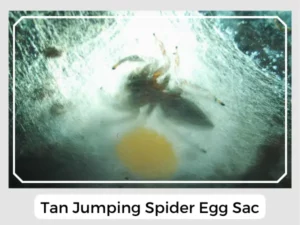Tan jumping spiders are super interesting! They hop around and belong to the jumping spider family. You can find them in places like North and Central America. Join us to uncover cool details about these jumpy little creatures!
During the summer season, eggs are laid in silken sacs mostly created under trees.

Photo Credit: .BlackCat.
Young spiders hatch in the same summer, especially after 3-4 weeks of birth.
Tan jumping spiders do not build webs, like other spiders of their family. Rather they wait for the prey and attack them at the slightest available opportunity.
Yes, Tan Jumping spiders have venom. But for humans, it’s usually very mild. They mostly use it to catch their tiny prey.
Tan Jumping spiders can bite if they’re startled. The bite might feel like a little pinch, but typically, it’s not a big concern for most people.
Tan Jumping Spiders play a crucial role in controlling the population of smaller spiders and maintaining ecological balance. They are diurnal hunters, actively pursuing prey during the day. Their impressive jumping ability, combined with excellent vision, makes them formidable predators in their tiny world.
Natural Predators and Prey-Predator Dynamics: In the wild, Tan Jumping Spiders face threats from birds, wasps, reptiles, and larger mammals. Their agility and cryptic coloration are their main defenses, helping them evade predators while they hunt for prey.
Relationship with Humans: Though Tan Jumping Spiders are venomous, their bite is not harmful to humans, and they are generally not considered a threat. In fact, their presence can be beneficial in controlling the population of other, potentially more harmful spiders.
| Distribution | Central and North America |
| Habitat | Vertical surfaces like walls, fences, and tree trunks |
| Lifespan | Around 1 year |
| Predator | Birds, wasps, reptiles, and big mammals |
| Diet | Smaller spiders |
| IUCN Conservation Status | Not Listed |
In conclusion, the Tan Jumping Spider is a remarkable species, showcasing incredible agility and unique adaptations that enable it to thrive in its environment.
Tan jumping spiders are super interesting! They hop around and belong to the jumping spider family. You can find them in places like North and Central America. Join us to uncover cool details about these jumpy little creatures!
During the summer season, eggs are laid in silken sacs mostly created under trees.

Photo Credit: .BlackCat.
Young spiders hatch in the same summer, especially after 3-4 weeks of birth.
Tan jumping spiders do not build webs, like other spiders of their family. Rather they wait for the prey and attack them at the slightest available opportunity.
Yes, Tan Jumping spiders have venom. But for humans, it’s usually very mild. They mostly use it to catch their tiny prey.
Tan Jumping spiders can bite if they’re startled. The bite might feel like a little pinch, but typically, it’s not a big concern for most people.
Tan Jumping Spiders play a crucial role in controlling the population of smaller spiders and maintaining ecological balance. They are diurnal hunters, actively pursuing prey during the day. Their impressive jumping ability, combined with excellent vision, makes them formidable predators in their tiny world.
Natural Predators and Prey-Predator Dynamics: In the wild, Tan Jumping Spiders face threats from birds, wasps, reptiles, and larger mammals. Their agility and cryptic coloration are their main defenses, helping them evade predators while they hunt for prey.
Relationship with Humans: Though Tan Jumping Spiders are venomous, their bite is not harmful to humans, and they are generally not considered a threat. In fact, their presence can be beneficial in controlling the population of other, potentially more harmful spiders.
| Distribution | Central and North America |
| Habitat | Vertical surfaces like walls, fences, and tree trunks |
| Lifespan | Around 1 year |
| Predator | Birds, wasps, reptiles, and big mammals |
| Diet | Smaller spiders |
| IUCN Conservation Status | Not Listed |
In conclusion, the Tan Jumping Spider is a remarkable species, showcasing incredible agility and unique adaptations that enable it to thrive in its environment.